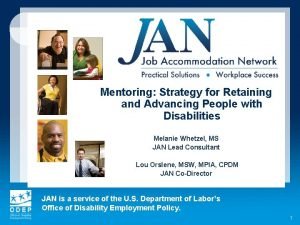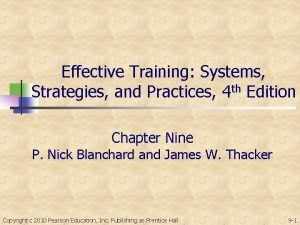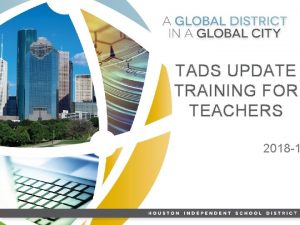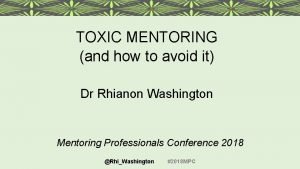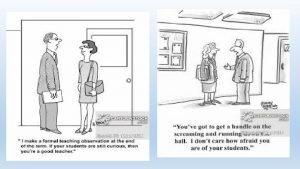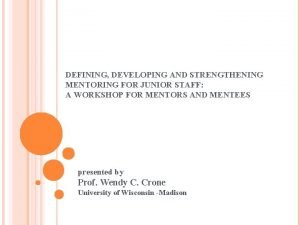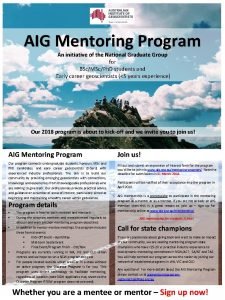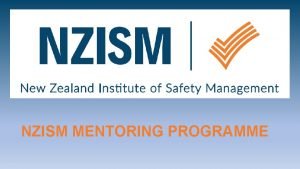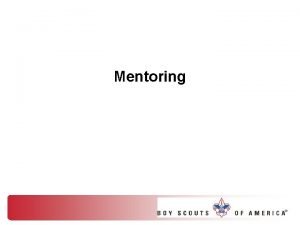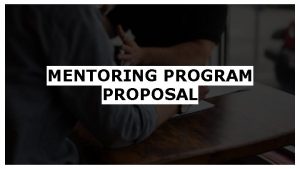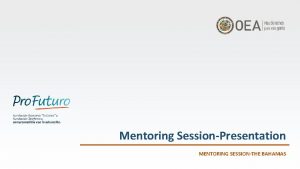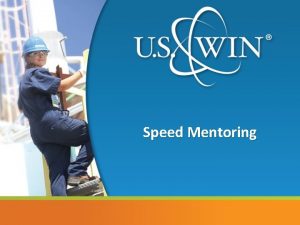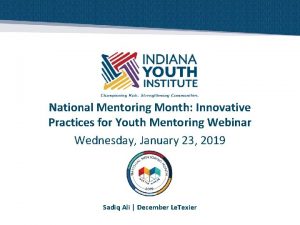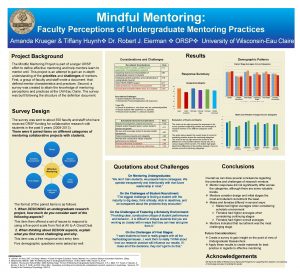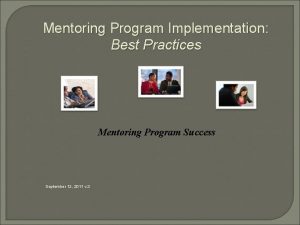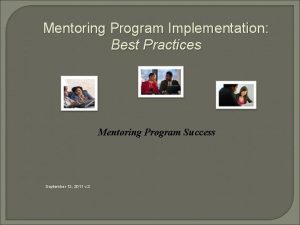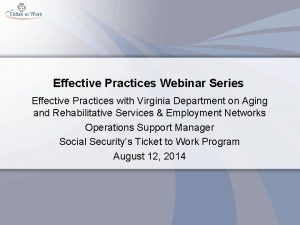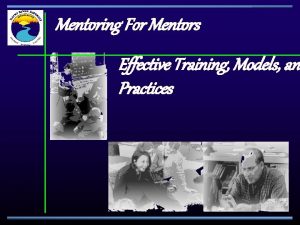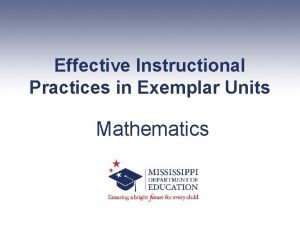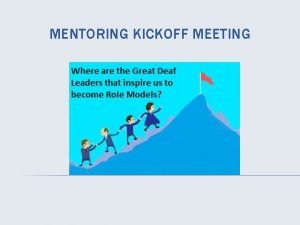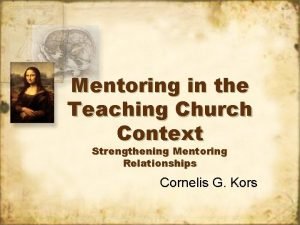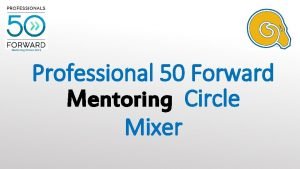Mentoring for Effective Instructional Practices Dr Lisa LachlanHach













































































- Slides: 77

Mentoring for Effective Instructional Practices Dr. Lisa Lachlan-Haché & Amy Colpo April 25 & 26, 2019 Copyright © 2019 American Institutes for Research. All rights reserved.

Consensogram Warm-Up § Use sticky dots to record your answers to the following questions on the chart papers located around the room: • • • Where are you from? Years of experience as a teacher Years of experience as a mentor Number of mentees you are supporting Are you a full or part-time release mentor? What content areas/roles do your mentees represent? 2

Welcome! § Review consensograms § Introductions • • Name School and location Brief statement about the number/type of teachers you support ONE WORD that captures your favorite part of being a mentor § Partner matching activity 3

Objectives § Mentors will develop a deeper understanding of the essential components of four high-leverage practices (HLPs): • • Explicit instruction Systematically-designed instruction Scaffolded supports Positive and constructive feedback to guide student learning § Mentors will practice strategies for observing, coaching, and giving feedback to beginning teachers to strengthen their use of HLPs in the classroom. 4

Review Materials § Agenda § Notetaking Guide § Handouts 5

Mission The mission of the Center on Great Teachers and Leaders (GTL Center) is to foster the capacity of vibrant networks of practitioners, researchers, innovators, and experts to build and sustain a seamless system of support for great teachers and leaders for every school in every state in the nation. 6

Comprehensive Centers Program 7

Mentoring and Induction Toolkit § The purpose of the GTL Center’s Mentoring and Induction Toolkit is to give regional comprehensive centers (RCCs) and state education agencies (SEAs) tools, resources, and support to facilitate meaningful conversations with local education agencies (LEAs) to design and implement effective, high-quality mentoring and induction programs. 8

Overview of the Toolkit § Module 1: Introduction to the GTL Mentoring and Induction Toolkit § Module 2: Mentor Recruitment, Selection, and Assignment § Module 3: Mentor Professional Learning, Development, and Assessment § Module 4: Beginning Teacher Professional Learning and Development § Module 5: The Role of the Principal in Mentoring and Induction § Module 6: Mentoring and Induction for Educators of Students with Disabilities § Module 7: Collecting Evidence of Induction Program Success 9

Module Components § Anchor Presentation: Summarizes research and best practices related to the topic. § Handouts: Provide information to supplement the anchor presentation. § Team Tools: Help teams plan, design, and implement the components of a comprehensive mentoring and induction program. 10

Access to Toolkit Materials § Anchor presentations, handouts, and team tools are available on the GTL Center website. § RCC and SEA personnel may request consultation from GTL experts to learn more about customizing the toolkit materials. 11

Overview of High Leverage Practices (HLPs) 12

What Are HLPs? “A set of practices that are fundamental to support K– 12 student learning, and that can be taught, learned, and implemented by those entering the profession. ” (Windschitl, Thompson, Braaten, & Stroupe, 2012, p. 880) 13

How Are HLPs Used? § HLPs are practices that can be woven into core instruction in the general education setting to intentionally design, deliver, and assess instruction that leads to equitable learning outcomes for all students, including students with diverse learning needs. 14

Features of HLPs § Focus directly on instructional practice § Occur with high frequency in teaching § Research based and known to foster student engagement and learning § Broadly applicable and usable in any content area or approach to teaching § Fundamental to effective teaching when skillfully executed Source: Council for Exceptional Children and CEEDAR (2017) 15

Why Should We Focus on HLPs? § We can define effective practice for teachers, assess it, and then improve it! § We can create a seamless system of support for teachers throughout their career. § HLPs are content agnostic and can be used across all grades. § HLPs have been identified as practices all novice teachers should know and be able to do. 16

HLP Frameworks HLPs in Special Education (examples) • • • Explicit instruction Systematic instruction Flexible grouping Active student engagement Positive and constructive feedback • Organized and respectful learning environments Teaching Works HLPs (examples) • Explaining and modeling content and practices • Coordinating and adjusting a lesson during instruction • Specifying and reinforcing productive student behavior • Building respectful relationships with students 17

Engage and Interact § EXPLORE: Review the High-Leverage Practices in Special Education handout. § DISCUSS: What did you notice about the HLPs on the handout? Do the practices listed on the handout align with what you have experienced as areas of need for beginning teachers? 18

So, HLPs Are Just Good Teaching? § Yes … and no. • HLPs intentionally and systematically increase the intensity of core/Tier I instruction. • HLPs must be intentionally selected and employed with student needs in mind. • HLPs help bridge the gap between student needs and the learning task. 19

A Few Caveats § HLPs do not replace the need to teach content using evidence-based practices. § HLPs do not imply that learning to teach is simply a matter of mastering these HLPs. § Our purpose today is not to teach you about the HLPs, but rather how to be more intentional about mentoring and coaching beginning teachers in their use of HLPs. 20

True or False? 1. ) HLPs are just for special education teachers. • FALSE. HLPs are for all teachers! 2. ) When used effectively, HLPs can help promote equitable outcomes for SWDs and others with special learning needs. • TRUE! HLPs can lead to improved student learning outcomes for all students in core instruction. 3. ) HLPs are the same as evidence-based practices. • FALSE. HLPs can be used in conjunction with evidencebased practices to teach important concepts and skills. 21

Example of HLPs and EBPs Working Together at Tier 1 § Evidence-based practices (EBPs) are: • Content specific • Subgroup specific • Taught using HLPs Explicit and systematic instruction (HLP) Phonics-based instruction for decoding (EBP) 22

High-Leverage Practices: The Foundation of Mentoring & Induction 23

A Common Language for Core Instruction Source: Billingsley, Bettini, & Jones (in press). 24

Oregon’s Context § Review the Oregon Mentoring Program Standards. How can supporting beginning teachers to effectively use HLPs advance the standards? • Standard 7: Instructional and Leadership Practices • Standard 8: Equity, Cultural Competence, and Universal Access 25

Roles and Stances of An Effective Mentor § The goal of today’s session is to be able to combine the content of HLPs with the coaching processes you have already learned as an experienced mentor. Consultant Collaborator Coach 26

Learning Tools § Practice Opportunities: There are five practice opportunities embedded in today’s session. For these exercises you will be asked to take on the role of a mentor or beginning teacher. Remember to adopt your “mentor stance” using the 3 Cs whenever you see this icon. 27

Learning Tools § Mentor-to-Mentor Reflective Conversations: After each practice opportunity, you will have a chance to shed your “mentor stance” to debrief with a partner about what went well and what could be improved about your mentor practice (actions, questioning techniques, language, etc. ). § Gallery Walk: We will periodically pause to reflect on our learning about the HLPs. Ideas, strategies, and questions will be recorded and captured in a gallery walk at the end of the session. 28

HLP Focus Today, we will focus on these HLPs: § #16: Use explicit instruction. § #12: Systematically design instruction toward specific learning goals. § #15: Provide scaffolded supports. § #8/22: Provide positive and constructive feedback to guide students’ learning and behavior. 29

Why These Four HLPs? § Essential for effective Tier 1 core instruction § Backed by a strong body of research § Used together to create lessons that are intentionally structured to address the needs of students within core instruction 30

Explicit Instruction 31

What Is Explicit Instruction? § Overtly teaching the steps or processes needed to understand a construct, apply a strategy, or complete a task § Offers multiple opportunities for modeling and practice with fading supports I Do We Do You Do 32

From the Authors “It is called explicit instruction because it is an unambiguous and direct approach to teaching that is characterized by a series of supports or scaffolds, whereby students are guided through the learning process with clear statements about the purpose and rationale for learning the new skill, clear explanations and demonstrations of the instructional target, and supported practices with feedback until independent mastery has been achieved. ” – Archer & Hughes, 2011, p. 1 33

Essential Components § § § § § Direction instruction of new skills or concepts (Hattie ES = 0. 59) Teacher modeling Concrete examples and visuals Worked examples (Hattie ES = 0. 57) Providing examples and non-examples Clarity of language and purpose Activating background knowledge Step-by-step instruction Gradual release of responsibility Immediate corrective feedback 34

Explicit Instruction Video Example § Watch: HLP #16—Explicit Instruction § Discuss: Which essential components of explicit instruction presented in the video do you most often see beginning teachers struggle with? 35

New: Observation Tools Aligned with HLPs § Effective Instruction Walkthrough: Explicit Systematic Instruction § Effective Instruction Walkthrough: Scaffolded Practice § Observing: Features of Effective Instruction 36

Review: Coaching Guides and Tools § Roles and Stances of an Effective Mentor—The 3 Cs § Learning Focused Conversations Guide § Mentoring Language Chart § Collaborative Discussion Guide 37

Practice Opportunity #1: It’s Peanut Butter Jelly Time! § We need 4 volunteers to act as students. § The “beginning teacher” will deliver an explicitly-designed lesson on how to make a peanut butter and jelly sandwich (just the “I do” and “we do” portions). § Everyone else will observe the lesson using the Effective Instruction Walkthrough: Explicit Systematic Instruction tool. 38

Feedback Time § Several volunteers will share their feedback directly with the “beginning teacher. ” Remember to adopt a mentoring stance and use effective mentoring language when giving feedback (use the Mentor Language Chart for ideas!) § Please focus on one specific item of feedback at a time in order to give multiple people a chance to share. § Whole Group Debrief: What went well about giving feedback on explicitly-designed instruction? What are some areas for improvement? 39

Pause and Reflect: Explicit Instruction § Record your thoughts on sticky notes and post on the gallery walk chart paper: • What are some key takeaways about this HLP? • What are some question stems/prompts that can be used with beginning teachers to help them reflect on this HLP? • What are some data points that can be used to help beginning teachers identify if this HLP is an area of need? • Resources to share/resources needed? 40

Systematically-Designed Instruction 41

Essential Components § Clearly define expectations and learning goals § Reduce student confusion by breaking down complex tasks § Carefully sequence instruction • Begin with what students already know • Begin with higher utility skills • Move from easier to more difficult skills § Incorporate assessment and feedback 42

Identify Learning Goals Consider… § Oregon state curriculum § Instructional grade level (present level of performance) § Grade level § Intervention or Individualized Education Program (IEP) goals 43

Break Skills Into Component Parts § Task analysis § Chunking § Consider time, attention span, developmental age, complexity of skill § Make connections to previous skills 44

Sequence Skills § Teach according to logical hierarchy: • Simple then complex skills • Prerequisites before requirements • Unambiguous before ambiguous § Teach familiar then unfamiliar: • Make connections • Connect the known to the new § Teach big and main ideas before details § Separate skills and concepts that are similar before requiring discrimination § Teach commonly encountered skills before lower frequency content and skills 45

Activity: Task Analysis § Whole Group: Break down the following learning task into its component parts. § Small Groups: How would you sequence instruction of the component parts of this task to create a systematically-designed lesson? In other words, what would you say first, second, third? Remember to sequence the skills from simple to complex. 46

Practice Opportunity #2: Reteach § Roles: Find your vacation partner. One partner will act as the beginning teacher and the other partner will act as the mentor. § Scenario: The beginning teacher has just delivered a lesson on [insert choice of topic here] that did not go well. The mentor is meeting with the beginning teacher to help coach them through the creation of a systematicallydesigned lesson to reteach the concept or skill. § Topic: Choose a lesson topic that you have seen a beginning teacher struggle with. 47

Reminders § Think about how you will adopt various stances (3 Cs) to help guide the beginning teacher. § Remember to guide the teacher through the essential components of systemically-designed instruction: • Identify the learning goal • Break skills into component parts • Sequence the teaching of skills into a logical hierarchy 48

Partner Debrief: Mentor-to. Mentor Reflective Conversation Successes (improvement strategies, building relationships, management, etc. ): Focus (challenge, concern, collaborative project, etc. ): Evidence/Data Mentor’s Next Steps (things to keep in mind during the next practice activity): Support Needed: 49

Pause and Reflect: Systematically-Designed Instruction § Record your thoughts on sticky notes and post on the gallery walk chart paper: • What are some key takeaways about this HLP? • What are some question stems/prompts that can be used with beginning teachers to help them reflect on this HLP? • What are some data points that can be used to help beginning teachers identify if this HLP is an area of need? • Resources to share/resources needed? 50

Scaffolded Supports 51

What Are Scaffolded Supports? § Supports are scaffolded to help students with tasks that they are not ready to complete independently § Teachers consider performance, tasks, and processes § Apply to academics or behavior § May be preplanned or in the moment § Carefully chosen technology can provide scaffolded support for students 52

Examples of Scaffolded Supports § § § § § Graphic organizers Cue cards Semantic maps Manipulatives Use of technology Dialogue such as modeling and thinking aloud Prompts to focus students’ attention Partially completing a response or task Prompting and questioning Providing informative feedback 53

Systematic Instruction With Scaffolding 54

Gradual Release of Responsibility Explicit Instruction With Modeling Read Aloud Teacher Independent Reading Guided Practice Independent Student Shared Reading Collaborati on Guided Reading Source: Fisher & Frye, 2008

Practice Opportunity #3: Mentoring for Scaffolded Instruction § Roles: Stay with your vacation partner but switch beginning teacher and mentor roles. § Scenario: The beginning teacher is planning to reteach a lesson on [same topic as last time]. The mentor is meeting with the beginning teacher to help them think through scaffolded supports for all students. § Reminders: Focus mentoring prompts on scaffolded supports for all learners, checks for understanding, and gradual release of responsibility. 56

Partner Debrief: Mentor-to. Mentor Reflective Conversation Successes (improvement strategies, building relationships, management, etc. ): Focus (challenge, concern, collaborative project, etc. ): Evidence/Data Mentor’s Next Steps (things to keep in mind during the next practice activity): Support Needed: 57

Pause and Reflect: Scaffolded Supports § Record your thoughts on sticky notes and post on the gallery walk chart paper: • What are some key takeaways about this HLP? • What are some question stems/prompts that can be used with beginning teachers to help them reflect on this HLP? • What are some data points that can be used to help beginning teachers identify if this HLP is an area of need? • Resources to share/resources needed? 58

Positive and Constructive Feedback to Guide Student Learning 59

Why Is Feedback Important? § Increases engagement during instruction and improves student outcomes § Assists the teacher in monitoring student understanding § Prompts students to continue successful attempts during practice or to remedy errors before they become entrenched 60

Opportunities for Student Practice With Feedback § Offer individual practice opportunities to all students § Use frequent student response to monitor student understanding § Provide feedback that relates to student goals and completion of tasks § Provide feedback that is clear and precise § Communicate which aspects of the task students performed correctly § Connect feedback directly to student actions and learning goals 61

Key Considerations § Feedback cannot happen without providing students with opportunities to respond § Providing students with learning difficulties frequent opportunities to practice with teacher feedback throughout a lesson has been shown to accelerate learning (Hattie ES = 0. 73) 62

What Do Opportunities To Respond Look Like? Verbal Response Procedures • Choral • Partner • Teams and huddle groups • Individual Written Response Procedures Action Response Procedures • Writing tasks (words and pictures) • Whiteboards • Response cards/sheets • Role play • Gestures • Facial expressions • Hand signals

Practice Opportunity #4: Video Example § Observe: Mr. Raymond’s Algebra Class § Observe: Use the Observation Tool: Features of Effective Instruction to record notes. Pay special attention to how the teacher provides feedback to guide student learning. § Roles: Find your animal partner. One partner will act as Mr. Raymond and the other partner will act as the mentor. § Instructions: The mentor will debrief the lesson with “Mr. Raymond” using the Collaborative Discussion Guide. The focus should be on how the teacher provides feedback to guide student learning. 64

Partner Debrief: Mentor-to. Mentor Reflective Conversation Successes (improvement strategies, building relationships, management, etc. ): Focus (challenge, concern, collaborative project, etc. ): Evidence/Data Mentor’s Next Steps (things to keep in mind during the next practice activity): Support Needed: 65

Pause and Reflect: Positive and Constructive Feedback § Record your thoughts on sticky notes and post on the gallery walk chart paper: • What are some key takeaways about this HLP? • What are some question stems/prompts that can be used with beginning teachers to help them reflect on this HLP? • What are some data points that can be used to help beginning teachers identify if this HLP is an area of need? • Resources to share/resources needed? 66

Practice Opportunity #5: Lesson Plan Analysis § Roles: Stay with your animal partner but switch beginning teacher and mentor roles. § Scenario: The mentor is meeting with the beginning teacher to review an upcoming lesson plan. Review the lesson plan and provide feedback using the Collaborative Discussion Guide to help the teacher integrate today’s HLPs into the lesson: • Explicit instruction • Systematically designed instruction • Scaffolded supports • Positive and constructive feedback 67

Partner Debrief: Mentor-to. Mentor Reflective Conversation Successes (improvement strategies, building relationships, management, etc. ): Focus (challenge, concern, collaborative project, etc. ): Evidence/Data Mentor’s Next Steps (things to keep in mind during the next practice activity): Support Needed: 68

Wrap-Up 69

Gallery Walk § Do a gallery walk of the HLP strategies with your dessert partner. Discuss the following questions: • Which specific aspects of the HLPs will beginning teachers need the most support with? • How do the HLPs work together to support high-quality instruction? • What challenges will beginning teachers face in using these four HLPs to design and deliver lessons? 70

Whole Group Share Out § What is your biggest takeaway from this session? § What is one thing that you will implement right away with your mentees from this session? § What do you need in terms of further support? 71

Evaluation 72

References 73

References Archer, A. L. , & Hughes, C. A. (2011). Explicit instruction: Effective and efficient teaching. In What Works for Special Needs Learners, (Harris, K. , & Graham, S. , Series Editors). New York, NY: Guildford Press, p. 1. Billingsley, B. , Bettini, E. , & Jones, N. (In press). Supporting special education teacher induction through high leverage practices. Remedial and Special Education. Council for Exceptional Children and CEEDAR. (2017). High-leverage practices in special education (HLPs). Arlington, VA: Council for Exceptional Children & CEEDAR Center. Retrieved from Fisher, D. , & Frey, N. (2008). Better learning through structured teaching: A framework for the gradual release of responsibility. Alexandria, VA: ASCD. Windschitl, M. , Thompson, J. , Braaten, M. , & Stroupe, D. (2012). Proposing a core set of instructional practices and tools for teachers of science. Science Education, 96(5), 878 -903. doi: 10. 1002/sce. 21027 74

Further HLP Resources § HLPs in Special Education (full report) § HLPs for Inclusive Classrooms (book) § HLPs and Teacher Preparation in Special Education (research brief) 75

Disclaimer This content was produced under U. S. Department of Education, Office of Special Education Programs, Award No. S 283 B 120021. David Guardino serves as the project officer. The views expressed herein do not necessarily represent the positions or polices of the U. S. Department of Education. No official endorsement by the U. S. Department of Education of any product, commodity, service, or enterprise mentioned in this website is intended or should be inferred. 76

More questions? Contact the GTL Center! 1000 Thomas Jefferson Street NW Washington, DC 20007 -3835 877 -322 -8700 gtlcenter@air. org www. gtlcenter. org | www. air. org www. facebook. com/gtlcenter www. twitter. com/gtlcenter Advancing state efforts to grow, respect, and retain great teachers and leaders for all students 77
 Mentoring best practices
Mentoring best practices Effective training systems strategies and practices
Effective training systems strategies and practices Tads hisd
Tads hisd En lathund för arbete med kontinuitetshantering
En lathund för arbete med kontinuitetshantering Mat för idrottare
Mat för idrottare Gumman cirkel
Gumman cirkel Bästa kameran för astrofoto
Bästa kameran för astrofoto Anafor dikt exempel
Anafor dikt exempel Ledarskapsteorier
Ledarskapsteorier Publik sektor
Publik sektor Plagg i gamla rom
Plagg i gamla rom Vilken grundregel finns det för tronföljden i sverige?
Vilken grundregel finns det för tronföljden i sverige? Densitet vatten
Densitet vatten Ministerstyre för och nackdelar
Ministerstyre för och nackdelar Jätte råtta
Jätte råtta Vem räknas som jude
Vem räknas som jude Nationell inriktning för artificiell intelligens
Nationell inriktning för artificiell intelligens Tillitsbaserad ledning
Tillitsbaserad ledning Nyckelkompetenser för livslångt lärande
Nyckelkompetenser för livslångt lärande Sju för caesar
Sju för caesar Handledning reflektionsmodellen
Handledning reflektionsmodellen Matematisk modellering eksempel
Matematisk modellering eksempel Underlag för särskild löneskatt på pensionskostnader
Underlag för särskild löneskatt på pensionskostnader Verktyg för automatisering av utbetalningar
Verktyg för automatisering av utbetalningar Texter för hinduer tantra
Texter för hinduer tantra Cks
Cks Inköpsprocessen steg för steg
Inköpsprocessen steg för steg Skivepiteldysplasi
Skivepiteldysplasi I gullregnens månad
I gullregnens månad Strategi för svensk viltförvaltning
Strategi för svensk viltförvaltning Informationskartläggning
Informationskartläggning Variansen formel
Variansen formel Datorkunskap för nybörjare
Datorkunskap för nybörjare Tack för att ni har lyssnat
Tack för att ni har lyssnat Läkarutlåtande för livränta
Läkarutlåtande för livränta Treserva lathund
Treserva lathund Vad står k.r.å.k.a.n för
Vad står k.r.å.k.a.n för Påbyggnader för flakfordon
Påbyggnader för flakfordon Tack för att ni lyssnade
Tack för att ni lyssnade Egg för emanuel
Egg för emanuel Tack för att ni har lyssnat
Tack för att ni har lyssnat Tidbok yrkesförare
Tidbok yrkesförare Rutin för avvikelsehantering
Rutin för avvikelsehantering Vanlig celldelning
Vanlig celldelning Byggprocessen steg för steg
Byggprocessen steg för steg Presentera för publik crossboss
Presentera för publik crossboss Fspos vägledning för kontinuitetshantering
Fspos vägledning för kontinuitetshantering Myndigheten för delaktighet
Myndigheten för delaktighet Debatt mall
Debatt mall Kung dog 1611
Kung dog 1611 Tobinskatten för och nackdelar
Tobinskatten för och nackdelar Tack för att ni har lyssnat
Tack för att ni har lyssnat Tack för att ni lyssnade bild
Tack för att ni lyssnade bild Vad är referatmarkeringar
Vad är referatmarkeringar Sten karttecken
Sten karttecken Mjälthilus
Mjälthilus Shingelfrisyren
Shingelfrisyren Rådet för byggkompetens
Rådet för byggkompetens Arkimedes princip formel
Arkimedes princip formel Multiplikation uppställning
Multiplikation uppställning Elektronik för barn
Elektronik för barn Borra hål för knoppar
Borra hål för knoppar A gastrica
A gastrica Smärtskolan kunskap för livet
Smärtskolan kunskap för livet Bris för vuxna
Bris för vuxna Vad är ett minoritetsspråk
Vad är ett minoritetsspråk Novell typiska drag
Novell typiska drag Trög för kemist
Trög för kemist Autokratiskt ledarskap
Autokratiskt ledarskap Ellika andolf
Ellika andolf Steg för steg rita
Steg för steg rita Blomman för dagen drog
Blomman för dagen drog Redogör för vad psykologi är
Redogör för vad psykologi är Toxic mentoring
Toxic mentoring Mentoring peer observation
Mentoring peer observation Junior staff mentoring
Junior staff mentoring Aig mentoring program
Aig mentoring program Cross-company mentoring
Cross-company mentoring
